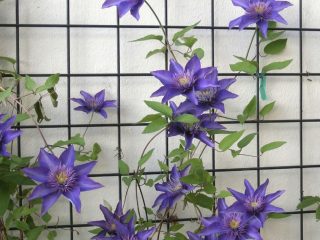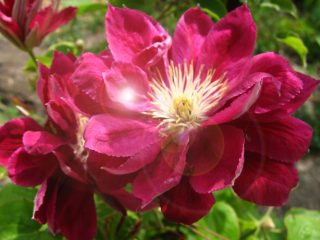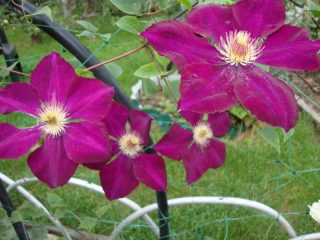Content
Large-flowered clematis Diamond Ball is a variety of Polish selection. It has been on sale since 2012. The originator of the variety is Szczepan Marchinski. Diamond Ball won a gold medal at the 2013 Grand Press in Moscow.
Description of clematis Diamond Ball
Clematis Diamond Ball lashes reach a length of 2 m. To grow upward, they need strong support. The plant is light-loving, blooms in June-July with large double flowers. The flowering is lush, almost from the base of the bush. Diamond Ball blooms again in August, but not so profusely.
The leaves of clematis are light green, trifoliate, compound or single, up to 10 cm long. The flower corollas are 10-12 cm in diameter, painted blue and white, and resemble a dahlia in shape.
Clematis Diamond Ball (pictured above) is recommended for growing in zones 4-9. Tolerates temperatures as low as -34 °C. Resistant to diseases, responds well to fertilizing and mulching the soil.
Clematis Diamond Ball pruning group
Clematis Diamond Ball belongs to the second group of pruning. It is pruned slightly in the fall, because the first flower buds appear on last year's shoots.The second wave of flowering occurs in summer. At this time, flowers bloom on young, annual shoots.
Planting and caring for clematis Diamond Ball
To create good conditions for Diamond Ball hybrid clematis, it is necessary to ensure timely watering and fertilizing, proper pruning, and protection from diseases and pests. Shoots need strong support for normal growth.
Planting of seedlings is carried out in the fall in September or in the spring. Choose a sunny place with fertile loamy soil. It is advisable to prepare a large hole with a depth and a diameter of 60 cm for clematis, put drainage at the bottom, and add the following components to the soil:
- peat;
- sand;
- humus or compost;
- 1 tbsp. complete mineral fertilizer;
- 1 tbsp. ash;
- 150 g superphosphate;
- 100 g bone meal.
The hole is filled approximately halfway with the prepared soil mixture, a mound is made and clematis is planted with the root collar deepened by 8-12 cm. Water the bush well and mulch the soil. Cover when the first frosts begin.
In the spring, remove excess mulch from under the clematis, leaving a layer 5-7 cm thick. It will retain moisture in the soil and protect it from overheating, and prevent weeds from germinating. It is undesirable to leave a large layer of mulch; the bases of the sprouts will die and the density of the bush will suffer.
Clematis Diamond Ball requires light pruning before bud break in April. If the bushes are not tall, they do not need to be pruned in the fall. In spring, the branches are cleaned by hand from dried leaves. Then weak, diseased and broken shoots are cut out.The remaining lashes are cut at a height of 1.5-1.7 m above strong buds, directing them to grow along the support. Thin and dead shoots are cut off near the ground, and dry petioles are removed. If left, they can serve as breeding grounds for disease. After the first flowering, you can carry out sanitary and formative pruning, removing broken branches that thicken the bush and faded buds.
Knowing the peculiarities of growing Diamond Ball clematis, you can provide it with good care. In the first half of summer, the plant is given organic fertilizers - compost, rotted manure. Mineral fertilizing will also be useful. Abundant flowering stimulates the introduction of microelements (boron, magnesium, iron, calcium) and potassium-phosphorus preparations. Horse manure can be used as mulch. When watering, the soil is deeply moistened. Clematis has a powerful root system and a large vegetative mass by 3-5 years.
Preparing for winter
In clematis of the second group, pruning of the first year of life of the lashes is cut at a height of 10 cm from the soil level. In the spring, new shoots of renewal will begin to grow, and in the second year you can try to preserve the lashes in the winter.
In regions with a cold climate, clematis are removed from their support, the shoots are shortened at a height of 1.5 m from the ground, and placed on a layer of mulch covering the soil under the bush. An air-dry shelter is built on top, as for roses - spunbond is pulled over the frame or over spruce branches.
Reproduction
The varietal clematis grandiflora Diamond Ball is most often propagated by cuttings. To obtain planting material, cut off the vine and divide it into parts, leaving 2 internodes on each.
The procedure for rooting cuttings:
- The lower leaves are cut off, the upper ones are shortened to reduce the area of moisture evaporation.
- Prepare a mixture of garden soil and sand.
- The cuttings are dipped with the lower cut into Kornevin and planted in small pots with prepared soil.
- Then water with settled warm water.
- Make a greenhouse for each cutting from a two-liter bottle, cutting off the bottom.
- Water as the soil dries.
- Place in diffused sunlight.
- After rooting, the cuttings are transplanted to a permanent place.
Clematis can also be propagated by layering or dividing the bush when replanting. This method gives a 100% guarantee of rooting, but the young bush takes a long time to grow. It takes 3-5 years for the plant to become an adult after rooting the cutting and layering or dividing the bush.
Diseases and pests
Clematis most often suffer from wilt. This disease manifests itself in the withering of shoots. The second group of pruning often causes disappointment among gardeners precisely because of the wilt; it is more intended for professionals, experienced gardeners.
This plant is resistant to pests. Aphids can settle on succulent young leaves and buds. For prevention, bushes are treated with any systemic insecticide.
Conclusion
Clematis Diamond Ball is distinguished by beautiful double flowers of a bluish color. It belongs to the second pruning group and needs shelter for the winter. The variety is frost-resistant, has strong immunity, and is rarely affected by diseases and pests.










